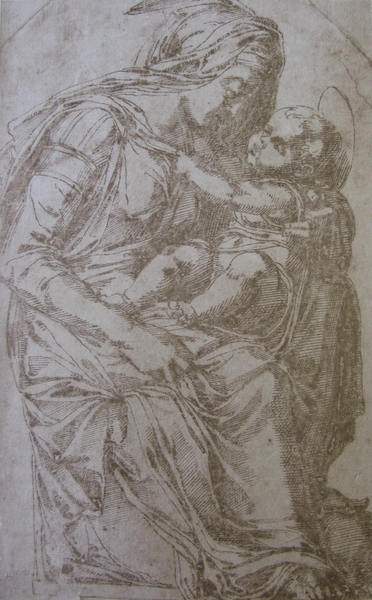The Virgin and Child
Summary
A reproduction produced by the Vasari Society of a drawing from the Florentine School. The drawing is made with thin lines, with lots of shading created by hatching and cross-hatching. It shows the Virgin Mary, wearing a headscarf and a long dress, holding the infant Jesus and bending her head down towards him. The child is seated on his mother's lap, and is reaching up with his left hand to tug at her clothing. Text from the accompanying booklet produced by the Vasari Society: "4. FLORENTINE SCHOOL (about 1500) THE VIRGIN AND CHILD Collection of Henry Oppenheimer, Esq. From the Benjamin West, Wellesley, Palgrave, and Heseltine Collections. Pen and bistre. The original paper damaged in various places and backed. 24.5 x 15.2 cm. (9 5/8 x 6 in.). This interesting drawing is identical in composition with a small marble relief, now generally accepted as the work of Desiderio da Settignano (1428-64), of which the best known version (with a rounded top) is in the Dreyfus Collection in Paris. Another version, closer to the drawing and apparently finer, is known from an old stucco at Berlin and from modern plaster casts (there is one in the Victoria and Albert Museum); in this the top is square. Neither version is appreciably larger than the drawing. Mr. Oppenheimer's drawing has been traditionally ascribed, with some others of more or less similar character, to Donatello; but it seems almost certainly to be of a later date, and it is probably a copy from, rather than a study for, the relief. As such it has been ascribed by Dr. von Bode (Italienische Bildhauer (1887), p. 57; Florentiner Bildhauer (1910), p. 170) and Dr. Strzygowski (Jahrbuch der k. Preussischen Kunstsammlungen, XII (1891), pp. 211 ff.) to Michelangelo, and by Dr. Wölfflin (Zeitschrift für bildende Kunst, second series, IV (1893), pp. 107-11), to one of the pupils of Baccio Bandinelli. Dr. Wölfflin has published (l. c.) a drawing by Bandinelli in the Uffizi (No. 1527) in which the upper part of the figure of the Virgin is clearly imitated from the same relief. In spite of a certain technical resemblance to Michelangelo's early studies, the laborious precision of Mr. Oppenheimer's drawing hardly supports an attribution to his hand; and many of the differences from the Dreyfus relief adduced in favour of this attribution by Dr. Strzygowski are already to be found in the square-topped version of the relief. It may be noted that while the relief itself is in the lowest possible stiacciato, the drawing seems to imply a transposition of it into the round or at least into alto rilievo. In spite of its small scale, Desiderio's relief exercised a considerable influence on Florentine artists. Apart from the two drawings, there is a much larger version in marble with additional figures of angels, by some not very distinguished follower of Donatello, in the Louvre (Arconati-Visconti Collection, No. 21). And less obvious reminiscences of it can be traced in the work of far greater artists. It has been pointed out by Dr. von Bode (ll. c.) and others that Michelangelo's early relief of the Madonna beside the Stair in the Casa Buonarroti was probably inspired by Desiderio. But it does not seem to have been recognized that Leonardo da Vinci based his small early painting at Petrograd (the Madonna de Fiore, or 'Benois' Madonna) on the same relief; the pen-drawing in the British Museum (Berenson, 1027), published by Sir Sidney Colvin (Burlington Magazine, XX (1911-12), p. 230, Pl. B) as a study for that picture is unmistakeably imitated from Desiderio's marble, though the upper part of the Virgin's figure has been altered so as completely to change the relation of the Mother to the Child. Many late modifications of the motive have been collected by Dr. Gronau in the Zeitschrift für bildende Kunst, XXIII (1912), pp. 253 ff. E. R. D. M. [Original Drawings by old Masters of the Italian School. Forming part of the Collection of J. P. H. (1913), No. 21.] The drawing is clearly Florentine of the end of the fifteenth or beginning of the sixteenth century. Michelangelo's early pen-drawings offers many points of resemblance, but it is more varied in its linear system, his lines are generally more curved, often shorter in stroke, in fact more subtly adapted to the expression of the modelling. If Michelangelo's, it must be one of his earliest in the Medici Gardens, i.e. about 1490, and as such would lead naturally from Desiderio to his own sculpture relief of the Madonna beside the Stair. This is the most attractive and picturesque solution, but it must be admitted that most of the drawings attributed to Michelangelo in this more regularly parallel and less sensitive mode (e.g. Two standing draped Figures, with a study of a head on the reverse, Oxford, J.C.R. 2, and Three Studies from an Antique Statue of Venus, Oxford, J.C.R. 3) are not generally regarded as his work. The difference is clearly seen by comparison of a sheet of studies after the antique (including the same Venus) at Chantilly (Frey No. 2) and the Oxford drawing (J.C.R. 3), which Frey tentatively ascribes to Bandinelli; Berenson to Passerotti. On its own merits it would seem that the present drawing is more likely to be by Bandinelli (though it is of finer and more sensitive quality than the other drawing suggested by the same relief, and attributed to Bandinelli, Uffizi, No. 1527) or by some unidentified contemporary, rather than by Michelangelo. A. M. H."
Object Name
The Virgin and Child
Creators Name
Date Created
1924
accession number
1924.77
Collection Group
Place of creation
Europe
Medium

